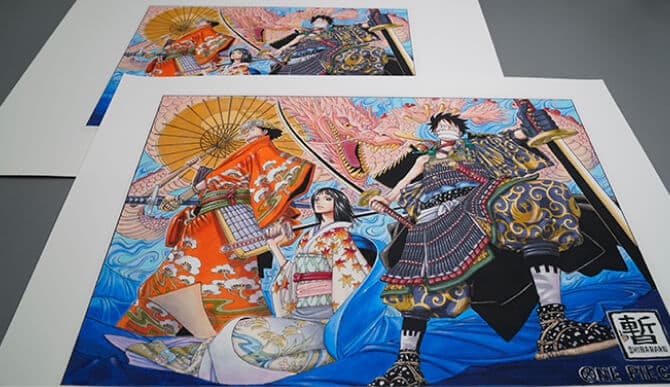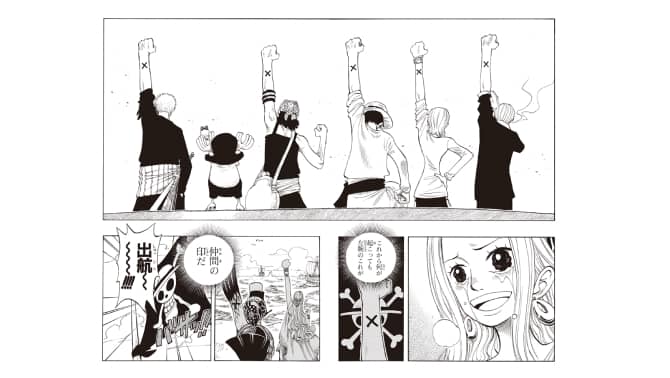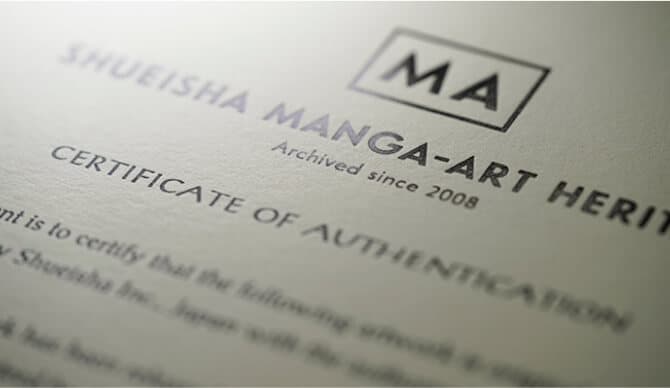

LABEL
Shueisha Manga-Art Heritage offers works under the following labels.

Real Color Collection
Never-before-seen color and detail
A collection featuring realistic colors that cannot be produced with the offset printing process used for comics and manga magazines. Available in two sizes, A2 (420 mm x 594 mm) and A1 (594 mm x 841 mm). This collection is printed on the 100% cotton velvet fine art paper used in museum collections.
At Shueisha, we have been digitally archiving manga since 2007. We initially captured color originals with the EverSmart Supreme II high-precision scanner. Since 2015, we have been using the Phase One IQ180 high-resolution digital camera. As of 2020, we are using the iXG100MP model from Phase One's Cultural Heritage series. We are able to capture and save ranges of color that cannot be reproduced by commercial printing, and we can even capture the texture of the paper that the artist used. The digital paintings are readjusted and added to by the artist using original RGB data.
For the Real Color Collection label, we send these captured and adjusted images to a printer that has undergone color management. The pigmented inks used in Epson inkjet printers are light-resistant and retain their original color even in the kind of light conditions that would cause dye color inks used on the originals to fade.
* Please note we cannot guarantee light resistance and durability when exposed to strong UV light outdoors, etc.
Not only do the ranges of color exceed those produced by the offset printing methods used for comic covers, but we are also able to achieve levels of light resistance and durability that even exceed those of the original pictures drawn on paper.
A set of original size prints and enlarged original prints
The collection, based on works drawn on paper, contains a set of two types of prints, one in the original size (often B4) drawn by the artist, and another enlarged to A2–A1 size. One can witness the precision that went into the original size prints. The blown-up prints allow one to feel the impact of the work and notice details that only become apparent when the artwork is enlarged.
* Please note that not all collections include both kinds of prints. For details, refer to the information provided for each individual work.

The original box includes a blockchain-linked sales certificate
All works are registered to Startrail PORT, NFT management service. Works include a blockchain-linked sales certificate with an affixed NFC tag sticker (letterpress printed by Kazui Press). You can view the information recorded on the NFT by scanning the NFC tag sticker with a smartphone. We send you the artwork in an original Shueisha Manga-Art Heritage box.

Blockchain-linked sales certificate (letterpress printed by Kazui Press, linked with NFC tag sticker)
Matte paper
Special paper to absorb any harmful substances
Instruction manual
Storage case (Foil stamped interior/exterior)

The Press
Revisiting manga's roots with flatbed letterpress printing
Since its inception, the black and white storytelling medium known as manga has been produced by the letterpress, the most primitive method of printing. Even today, Shonen Jump and other manga magazines are created using the letterpress rotary printing method commonly known as katsurin.
However, flatbed letterpress machines, which were once frequently used for proof printing and small print jobs, are rarely in use today. These machines, especially those capable of printing in A2 size, are in very limited operation in Japan and around the world.
Is it possible to take manga, which has always been a medium optimized for letterpress, and turn it into artworks using the highest possible quality of letterpress?
This was the question we wanted to answer.
Pressing using a Heidelberg printing press manufactured in the 1960s
With the help of Kyodo Printing, a company which prints Shonen Jump, we found a working letterpress in Nagano Prefecture, as well as skilled staff who are capable of operating it. Using this German-made Heidelberg printing press from the 1960s, we use high pressure method to print on 100% cotton Gmund Cotton Max White art paper. This method produces a completely unique page surface with a physical effect that is impossible to achieve using offset printing, lithography, or silkscreen printing. Touching the paper makes palpable how the art is embossed into the page.
These collections were made with the purpose of passing down to future generations the increasingly rare machinery and techniques used to create the manga in addition to the artworks themselves.

The original box includes a blockchain-linked sales certificate
All works are registered to Startrail PORT, NFT management service. Works include a blockchain-linked sales certificate with an affixed NFC tag sticker (letterpress printed by Kazui Press). You can view the information recorded on the NFT by scanning the NFC tag sticker with a smartphone. We send you the artwork in an original Shueisha Manga-Art Heritage box created by Misuzudo.

Blockchain-linked sales certificate (letterpress printed by Kazui Press, linked with NFC tag sticker)
Matte paper
Special paper to absorb any harmful substances
Instruction manual
Storage case (a bespoke box made by Misuzudo. Foil stamped interior/exterior)

The Millennium
Passing down manga for the next one thousand years
Drawn in the 12th and 13th centuries, the Chôjû-giga (animal caricatures) handscrolls are thought by some scholars to represent Japan's oldest manga. They were made over 900 years ago. The scrolls were created during Japan's late Heian to Kamakura periods, which marked the birth of the samurai class and the feudal system. More than athousand years have passed since then.
We would like to pass down manga for as long as possible into the future. To achieve this, we decided to do a deep dive into the origins of manga.
The most commonly used paper dimensions in Japan are A and B sizes. The most commonly used dimensions for paper used in manga is B size. Manga are usually illustrated on B4 (257 × 364 mm) and scaled down to B5 (182 × 257 mm) for publication in magazines. While A size is an international standard, B size is actually the Japanese domestic standard. Its origins are said to lie in minoban, the size of washi paper dating from the Edo period.
For this reason, manga original drawings (genga) and ukiyo-e are almost identical in size.
Going further back in history, Japan's oldest piece of paper, stored in the Shôsôin Repository (which dates to the 8th century), was made in Mino as well. The document was a family registry form submitted for the Taihô Code issued in 702 AD. The paper was made more than 1,300 years ago, and yet, it still retains its original form today.
Shueisha Manga-Art Heritage consulted Marujyu Paper Company, based in Mino, Gifu Prefecture, to request production of handmade Japanese paper. The result was an original kind of washi paper featuring a MA logo watermark.

The unique colors produced through collotype printing
Collotype is a printing technique originating in the mid-19th century when photography was invented. Said to be the oldest method of photoengraving, the method uses pigment ink and gelatin to create prints. Rather than using dots to produce shading, gelatin "wrinkles" are used to add gradation to photographs and pictures. These days, however, collotype presses are used only for limited purposes, such as the reproduction of cultural artifacts, and companies with technicians who can operate collotype presses are hard to find anywhere in the world.
There is one company in Kyoto that carries on this printing tradition. Benrido, a collotype studio, was founded in 1905. We commissioned our prints from this studio, which has been tasked with the reproduction of national treasures and important cultural assets for over a century.
While normal offset printing uses a combination of four CMYK colors, collotype printing produces images by mixing special colors according to the work being printed, with one layer of color printed at a time. The process uses a very hard ink with an average pigment concentration of 60%. This makes it an ideal printing method for works to be preserved in long term, and proof can be seen in collotype prints dating from a century ago.

Blockchain-linked sales certificate included
All works are registered with Startrail PORT, an blockchain certificate service. You can view the information recorded on the NFT by scanning the NFC tag sticker with a smartphone.
By combining Mino washi paper, collotype printing, and blockchain-linked sales certificates, we present a unique form of art to the world through a blend of technology and tradition.
Blockchain-linked sales certificate (letterpress printed by Kazui Press, linked with NFC tag sticker)
Instruction manual
Storage case

The Original
A one-of-a-kind item that includes the artist's original works
These works of art feature the artists' own paintings executed by hand. Only one of each piece exists in the world.
One example is "Blood Painting" by Shinichi Sakamoto. Sakamoto is an artist who draws manga in full digital format, but for this piece, he used "clotted blood" to paint over an inkjet print of Marie, the heroine of Innocent Rouge. Marie is depicted with overwhelming precision and detail, and blood trickles vividly down the artwork.
These original works, which are created using a wide range of materials, methods of presentation, and sizes, will be announced and sold as they become available.

• Scene from Shinichi Sakamoto's Innocent Exhibition (Yurakucho Epsite Gallery, November 16–December 11, 2019)
Plans for Gallery Exhibitions, etc.
Exhibitions and previews are also scheduled to be held in cooperation with galleries and museums. Details will be posted on the News page and on X (formerly Twitter).

All works are registered to Startrail PORT, NFT management service. Works will be delivered with a blockchain-linked sales certificate with an affixed NFC tag sticker (letterpress printed by Kazui Press). You can view the information recorded on the NFT by scanning the NFC tag sticker with a smartphone.
VISION/ LABEL